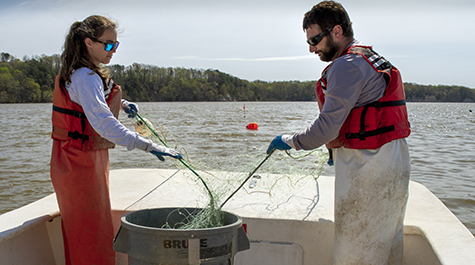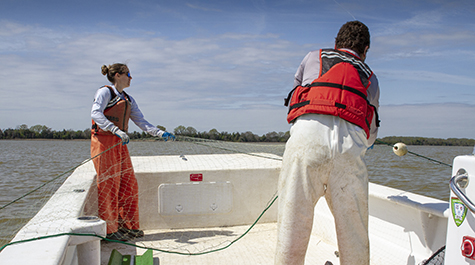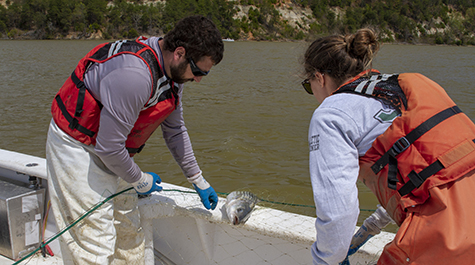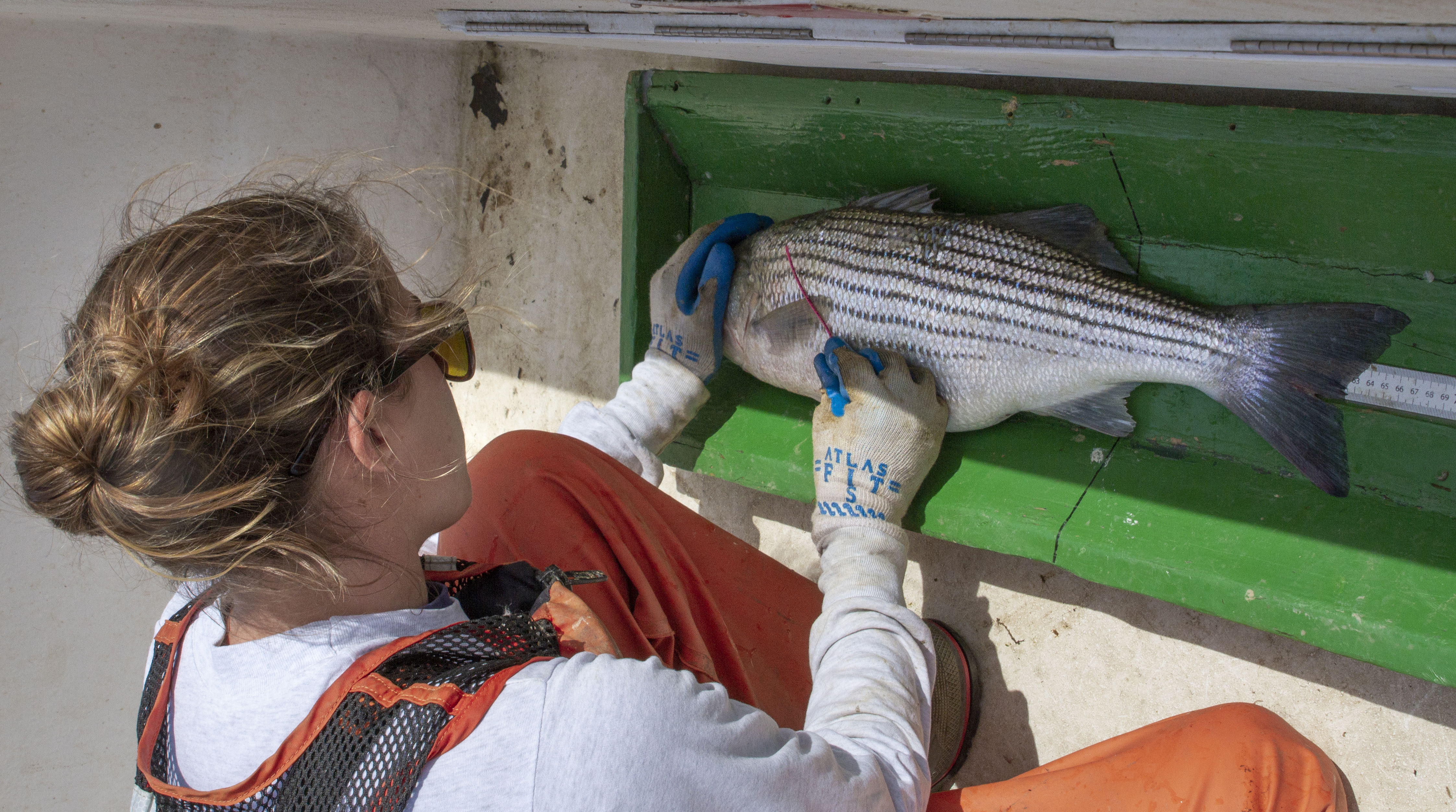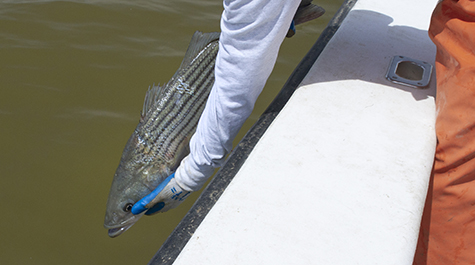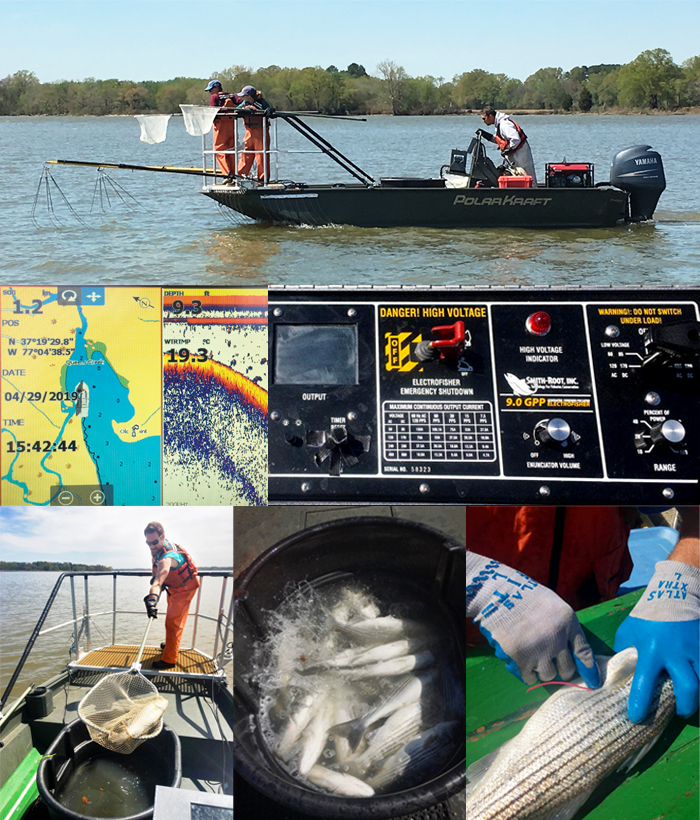Evaluation of Striped Bass Stocks in Virginia: Monitoring and Tagging Studies
The Striped Bass Program of the Virginia Institute of Marine Science (VIMS) has monitored the size and age composition, sex ratio and maturity schedules of the spawning striped bass stock in the Rappahannock River since 1981. In conjunction with the monitoring studies, VIMS established a tagging program in 1988 to provide information on the migration, relative contribution to the coastal population, and annual survival of striped bass that spawn in the Rappahannock River. This program is part of an active cooperative tagging study that currently involves 15 state and federal agencies along the Atlantic coast. The Atlantic States Marine Fisheries Commission (ASMFC) and the U.S. Fish and Wildlife Service (USFWS) coordinate the program.
Life History
On the Atlantic coast, striped bass range from the St. Lawrence River in Canada to the St. John’s River in Florida. Migratory populations under management of the Atlantic States Marine Fisheries Commission range from Maine through North Carolina. This fish is a long-lived species (at least up to 30 years of age) that normally spends the majority of its adult life in coastal estuaries or the ocean, migrating north and south seasonally, and ascending rivers to spawn in the spring. Mature female striped bass (age 4 and older) produce large quantities of eggs (up to 500,000), which are fertilized by mature males (age 2 and older) as they are released into riverine spawning areas. The fertilized eggs drift downstream with currents while developing, eventually hatching into larvae. The larvae and post-larvae begin feeding on microscopic animals during their downstream journey. 
After their arrival in the nursery areas, located in river deltas and the inland portions of coastal sounds and estuaries, they mature into juveniles. Striped bass remain in coastal sounds and estuaries for two to four years, before migrating to the Atlantic Ocean. In the ocean, fish tend to move north during the summer and south during the winter. Important wintering grounds for the mixed stocks are located from offshore of New Jersey to as far south as North Carolina. With warming water temperatures in the spring, the mature adult fish migrate to the riverine spawning areas to complete their life cycle.
Seasonal Striped Bass Migration Map
|
MonitoringTwo anchored gill nets are set on both the James River and the Rappahannock River. Each net is 300’ long, with ten 30' panels. The panel order is randomly selected each year, alternating between large and small meshes. The top line of the net is braided nylon polypropylene with 21 FL-106 PVC floats, and the bottom line of the net is 50 lb braided leadline. 22 lb danforth anchors hold the net in place with an orange flag attached to mark the ends of the net. A polyball is attached to the top line of the net, and an 8 lb mushroom anchor is attached to the leadline of the net on each end.
Nets are set for approximately 24 hours on each river. Typically, both rivers are set one day and fished the following day. Heavy catches may force us to set and fish rivers on separate days. The nets on the Rappahannock river are set ~1 mile upriver of Carter’s Wharf; the nets on the James are set just offshore of Westover plantation. A skiff is almost always used to set the nets, although the electrofishing boat is used at times. Nets are manually set with a crew of three people: the boat operator and two people to deploy net. Setting takes between 5-10 minutes per net depending on weather conditions. Nets are manually fished with a crew of 3 people (same as setting). The net is slowly pulled in over the bow of the boat, picking out all fish while pulling in net. Bycatch is recorded and often includes blue catfish, American shad, hickory shad, gizzard shad, river herring, white perch, and gar. Occasional bycatch includes carp, channel catfish, and menhaden. All stripers are brought back to the lab for biological workup. Data taken in the field includes: both surface and bottom depth, temperature, salinity, LDO, and LDO% as well as air temperature, wind speed/direction, barometric pressure, and tide. GPS coordinates are taken at each net site. Full workup of striped bass at VIMS includes data entry into FEED with measurement on an Icthystick electronic fish measuring board, weight via Marel scale, sex and maturity stage, and external assessments for mycobacteriosis. Scales and otoliths are removed for ageing, and spleens are taken for histological analysis. |
TaggingCommercial and recreational anglers that target striped bass are encouraged to report all recovered tags to the U.S. Fish and Wildlife Service (USFWS). Although the initial purpose of the coast-wide tagging study was to evaluate efforts to restore Atlantic striped bass stocks, tagging data are now being collected to monitor striped bass mortality rates in a recovered fishery. Each year since 1991, during the months of March, April and May, VIMS scientists obtained samples of mature striped bass on the spawning grounds of the Rappahannock River. Electrofishing is the safest and preferred method for tagging fish. Electricity is created by the generator, regulated through the control box and passed through the umbrella arms into the water. The fish are stunned and then netted to be revived, measured, tagged and released. We use a Smith Root 9.0 GPP electrofishing system rigged up to a 21’ aluminum jon boat. Water conductivity and temperature are used to determine appropriate settings for the system. Shocking typically takes place along the mud flats of the rivers.
We record fork length and total length, sex if we are able to determine it, external assessment for Myco, and scales for ageing. We use a scalpel to make a small puncture on the left side of the fish, through the skin just below the lateral line and posterior to the pectoral fin. A nylon anchor tag is inserted just inside the body cavity.
|
Annual Reports & Publications |
FundingThe Striped Bass survey is currently funded by the Virginia Saltwater Recreational Fishing Development Fund - VMRC.
|


